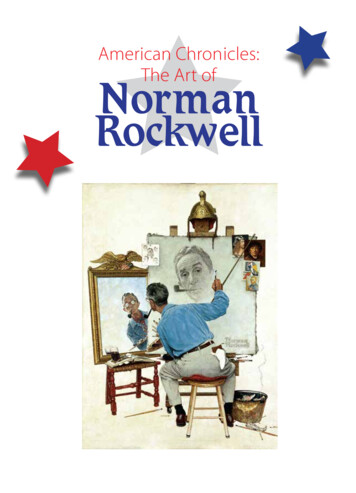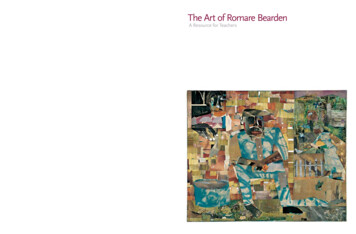
Transcription
American Chronicles:The Art ofNormanRockwell
America’smost prominent twentieth-century illustrator, NormanRockwell (1894–1978) worked within the realm of both aesthetics andcommerce. An astute visual storyteller and a masterful painter with adistinct, personal message to convey, he constructed fictional realities thatoffered a compelling picture of a life to which many Americans aspired.Anxiously awaited and immediately understood, his seamless narrativesseemed to assure reader engagement with the many publications thatcommissioned his work ―from the Saturday Evening Post, Ladies’ HomeJournal, and Boys’ Life to Look, which featured his most powerfulassertions on the social issues of his day. The complexities of artisticproduction remained hidden to his enthusiasts, who were compelled byhis vision and content to enjoy his art in the primary form for which it wasintended. What came between the first spark of an idea and a publishedRockwell image was anyone’s guess, and far more than his public wouldhave ever imagined.For many Americans, Rockwell’s icons of living culture were firstexperienced in the most unassuming of places, in the comfort of home,or on the train ride at the end of a long day. Created for the covers andpages of our nation’s periodicals rather than for the walls of galleries andmuseums, Rockwell’s images were intimately understood by a vast andeager audience who saw the best in themselves reflected in his art and inthe stories that he chose to tell.Beneath it all, Rockwell’s hopeful and admiring attitude toward humanitywas the hallmark of his work. He loved to paint pictures that conveyedstories about people, their attitudes toward each other, and his feelingsFig. 1about them. In 1943, a Time reporter said, “He constantly achieves thatcompromise between a love of realism and the tendency to idealize, whichis one of the most deeply ingrained characteristics of the American people.”
In 1977 Rockwell received the Presidential Medal of Freedom for havingportrayed “the American scene with unrivalled freshness and clarity,”and with “insight, optimism and good humor.” In a rapidly changingworld, Rockwell’s art had been areassuring guide for more thansix decades, and it continues toresonate today.American Chronicles: The Art ofNorman Rockwell represents fiftysix years in the artist’s career andfeatures many iconic works, someformerly in his personal collection,―from his 1914 interpretation ofAmerican folk hero Daniel Boonesecuring safe passage for settlersto the American West (fig. 2), tohis 1970 report on Americantourists and armed Israeli soldierswitnessingFig. 2aChristmasEveceremony at the Basilica of theNativity in Bethlehem (fig. 3).We invite visitors to comparetheir American experience withthat portrayed by Rockwell, andto consider how the artist’s visionmay have inspired their own.Fig. 3Telling Stories in Pictures“I love to tell stories in pictures,”Rockwell said. “For me, the story isthe first thing and the last thing.”Conceptualization was central forthe artist, who called the history ofEuropean art into play and employedclassical painting methodology toweave contemporary tales inspired byeveryday people and places. His richlydetailed, large-scale canvases offeredFig. 4.1far more than was necessary even by the standards of his profession,and each began with a single idea. By his own admission “hard to comeby,” strong pictorial concepts were the essential underpinnings of his art.From the antics of children, a favored theme of his youth, to the nuancedreflections on human nature that he preferred as a mature artist, eachpotential scenario was first cemented with a simple, thumbnail yofimagedevelopment that demanded theintegration of aesthetic concern andgraphic clarity.A perfectionist, Rockwell went toelaborate lengths to create referencephotographs,― sometimes as manyas one hundred for a major work,―that portrayed his concepts exactly.Scoutingmodelsandlocations,Fig. 4.2
researchingcostumesandAn ingenious aspect of this work is that Rockwell turned the problem intoprops, he carefully orchestratedits own resolution: not knowing what to paint has become the subjecteach element of his design toof his art. At one and the same time, Rockwell states his concern andbe photographed before puttinginvolves the viewer in his conundrum, making himself the subject of hispaint to canvas. (See figures 4.1–own joke. Hiding behind the humor is a statement of some seriousness.4.3.) Staging his scenarios forthe camera, the artist instructedhis photographers when andwhat to shoot as he directed acast of amateur actors. Rockwellproduced a wealth of photographsFig. 4.3for every new composition, whichhe then transferred, in whole or in part, to his final work.A storyteller at heart, Rockwell was a closet intellectual who knewand cared about the history and art of painting. Sometimes framed inhumor, narratives about the actof creating art and of viewingart were recurring themes in hiswork. The artist’s self-portrait,FacingBlankCanvas(The Deadline) (fig. 5) is a casein point. The blank canvas is aquandary for many artists, and inthis 1938 cover for the SaturdayEvening Post, Rockwell scratcheshis head in befuddlement with noFig. 5idea how to begin.the time his canvas was primed and on the easel, he had completed afully detailed charcoal drawing that was the same size as the canvas,and was ready to transfer the basic outlines of his composition onto hissupport. “Meeting deadlines and thinking up ideas are the scourges of anillustrator’s life,” Rockwell said. “This is not a caricature of myself, I reallylook like this.”Age of InnocenceArt Inspired by ArtArtistIn fact, Rockwell rarely began a painting at the oil-on-canvas stage. ByA popular theme in twentieth-century magazines, imagery reflecting thecarefree idylls of childhood launched Rockwell’s career and remaineda life-long focus. But in mid-twentieth-century America, childhood andRockwell’s conception of it were changing. The population swell of thebaby boom, women’s emerging role in the workplace, the cold war, andthe proliferation of nuclear weapons forced Americans to see the worldand themselves in a different light. As a perennial idealist, Rockwell didnot include the worries of the new generation in his work, but he did lookmore seriously at the subject of youth, depicting adolescents as morecomplex, dimensional people. Children were seen less at play and moreat learning how to grow up, ultimately to face the problems of a modernworld and deal with issues that were previously, in Rockwell’s words,“swept under the rug.”
few adjustments but he was removed—he was behind me somewhere.And he would speak to me. ‘Just move your head just a little yeah that’sgood, that’s good,’ very, very quietly. There was seriousness in that room.”Images for aChanging WorldIn the 1960s, leaving behind his beloved story-telling scenes, Rockwell threwhimself into a new genre—the documentation of social issues. He hadalways wanted to make a difference, and as a highly marketable illustrator,he had the opportunity to do so. Humor and pathos, traits that made hisSaturday Evening Post covers successful, were not needed for telling thestory of life in 1960s America. The textures and colors once used to weavehis lighthearted yarns were replaced by a direct, pared down, reportorialstyle more appropriate for magazine editorials.In the years that followed, Rockwell reported on civil rights issues and onthe space race, depicting the moon landing before and after it actuallyhappened. The artist’s 1963 painting, The Problem We All Live WithFig. 6One of Rockwell’s most evocative images, Girl at Mirror (1954, fig. 6) isa poignant reflection on life’s transition from childhood to adolescence, atransition that everyone experiences and understands. Youth is not quiteleft behind for this young lady, whose doll is cast aside but still close at hand.Rockwell commented that he regretted adding the magazine opened to apicture of actress Jane Russell, seen in the girl’s lap, for he felt that it datedthe painting too specifically. The artist auditioned at least three other modelsbefore selecting Mary Whalen for Girl at Mirror, who recalled, “there was alittle stool I sat on and he told me what to do. He might have made a(fig. 7), gently presents an assertion on moral decency. Inspired byyoung Ruby Bridges’s story, his first assignment for Look magazinewas an illustration of a six-year-old African American schoolgirl beingescorted by four U.S. Marshals to her first day at an all-white school inNew Orleans.Ordered to proceed with school desegregation after the 1954 Brownv. Board of Education ruling, Louisiana lagged behind until pressurefrom Federal Judge Skelly Wright forced the school board to begindesegregation on November 14, 1960. Rockwell’s focus on the brave
AboutNorman RockwellMuseumLocated in Stockbridge, Massachusetts, NormanRockwell’s hometown for twenty-five years, theNorman Rockwell Museum holds the largest andmost significant collection of art and archival materialsFig. 7girl, undeterred by the taunts of an unseen crowd, humanized the subjectfor many Americans. In seeing the published piece, one Florida readerwrote, “Rockwell’s picture is worth a thousand words . I am savingthis issue for my children with the hope that by the time they becomeold enough to comprehend its meaning, the subject will have becomehistory.”relating to the life and work of Norman Rockwell. TheMuseum also preserves, interprets, and exhibits agrowing collection of original illustration art by notedAmerican illustrators, from historical to contemporary.The Museum’s collections are a comprehensiveresource relating to Norman Rockwell and the art ofillustration, the role of published imagery in society, andAmerica in the twentieth century.Stephanie Plunkett, deputy director and chief curatorNorman Rockwell MuseumIllustrations: Cover and figure 8: Triple Self-Portrait. Cover illustration for The Saturday Evening Post, February 13, 1960. 1960:SEPS. Norman Rockwell Museum Collections; Figure 1: Beanie. Kellogg Company Corn Flakes advertisement, 1954. Norman RockwellFamily Agency. All rights reserved. Norman Rockwell Museum Collections; Figure 2: Daniel Boone, Pioneer Scout. Story Illustrationfor Boys’ Life, July 1914. Norman Rockwell Family Agency. All rights reserved. Norman Rockwell Museum Collections; Figure 3:Christmas Eve in Bethlehem. Story illustration for Look, December 29, 1970. Norman Rockwell Family Agency. All rights reserved.Norman Rockwell Museum Collections; Figure 4.1: Art Critic. Cover illustration for The Saturday Evening Post, April 16, 1955. 1955:SEPS. Norman Rockwell Museum Collections; Figure 4.2: Photographer Bill Scovill. Photograph of Mary Rockwell for Art Critic. Coverillustration for The Saturday Evening Post, April 16, 1955. Norman Rockwell Family Agency. All rights reserved. Norman RockwellMuseum Collections; Figure 4.3: Study for Art Critic. Cover illustration for The Saturday Evening Post, April 16, 1955. Norman RockwellFamily Agency. All rights reserved; Figure 5: Artist Facing Blank Canvas (The Deadline). Cover illustration for The Saturday Evening Post,October 8, 1938. 1938: SEPS. Norman Rockwell Museum Collections; Figure 6: Girl at Mirror. Cover illustration for The SaturdayEvening Post, March 6, 1954. 1954: SEPS. Norman Rockwell Museum Collections; Figure 7: The Problem We All Live With. Storyillustration for Look, January 14, 1964. Norman Rockwell Family Agency. All rights reserved. Norman Rockwell Museum CollectionsFig. 8
American Chronicles: The Art ofNorman RockwellNovember 1, 2013–February 9, 2014Frist Center for the Visual ArtsAmerican Chronicles: The Art of Norman Rockwell has been organized by theNorman Rockwell Museum in Stockbridge, Massachusetts.This exhibition is made possible with generous support from the National Endowment forthe Arts, American Masterpieces Program; the Henry Luce Foundation; Curtis Publishing Co.;Norman Rockwell Family Agency; and the Stockman Family Foundation.Presenting Sponsors: Anne and Joe RussellSupporting Sponsor:Hospitality Sponsor:The Frist Center for the Visual Arts gratefully acknowledges ourPicasso Circle Members as Exhibition Patrons.This exhibition is supported by an indemnity from the Federal Councilon the Arts and the Humanities.The Frist Center for the Visual Arts is supported in part by:Downtown Nashville, 919 Broadway, Nashville, TN 37203fristcenter.orgAccredited by the American Alliance of Museums, the Frist Center for the Visual Arts is a 501(c)3 nonprofit art exhibition centerdedicated to presenting and originating high quality exhibitions with related educational programs and community outreachactivities. The Frist Center offers the finest visual art from local, regional, national, and international sources in a program of changingexhibitions that inspire people through art to look at their world in new ways.
illustrator’s life,” Rockwell said. “This is not a caricature of myself, I really look like this.” Age of Innocence A popular theme in twentieth-century magazines, imagery reflecting the carefree idylls of childhood launched Rockwell’s career and remained a life-long f










